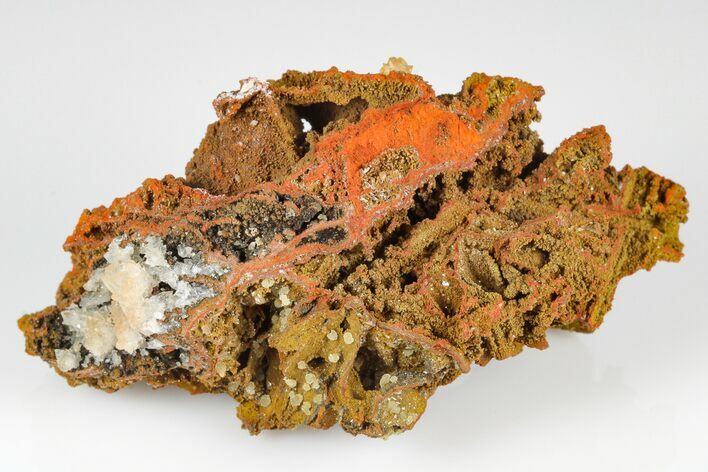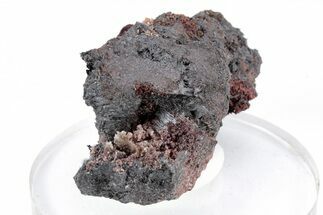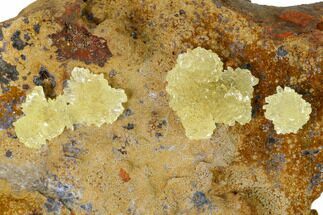This Specimen has been sold.
3.7" Limonite Pseudomorphs after Legrandite - Ojuela Mine, Mexico
This is a interesting pseudomorph specimen that was collected from the Ojuela Mine in Durango, Mexico. It features the casts of hexagonal legrandite crystals that were encased in limonite. Small calcite and what is likely adamite crystal formations can be found scattered throughout the limonite.
The entire specimen measures 3.7 x 2.1" and comes with an acrylic display stand.
The entire specimen measures 3.7 x 2.1" and comes with an acrylic display stand.
About The Ojuela Mine
Ojuela is not one mine but a complex of multiple mines in the same general area, located just northwest of Mapimi, Mexico. It was established in 1598 after the discovery of an old abandoned silver and gold mine. As mineral production increased and the mineral potential was confirmed, the town (Ojuela settlement) adjacent to the mine, along with the city of Mapimi, began to grow as well. The mining settlement was such a success that it contained a post office, warehouses, stores, saloons, a church, and housing for the miners. Once minerals were collected, they were processed in Mapimi, which also played a role in the rapid development of the city. Around the start of the 20th century, most of the mineral deposits were exhausted, resulting in the abandonment of the mines and settlement.
The mine is well known by mineral collectors for its aresenate minerals and a variety of other mineral species: approximately 117 have been identified from the area. Some of the most popular minerals include adamite, austinite, hemimorphite, scorodite, platternite, aurichalcite, rosasite, calcite, wulfenite, mimetite, iridescent goethite, and fluorite.
Ojuela is not one mine but a complex of multiple mines in the same general area, located just northwest of Mapimi, Mexico. It was established in 1598 after the discovery of an old abandoned silver and gold mine. As mineral production increased and the mineral potential was confirmed, the town (Ojuela settlement) adjacent to the mine, along with the city of Mapimi, began to grow as well. The mining settlement was such a success that it contained a post office, warehouses, stores, saloons, a church, and housing for the miners. Once minerals were collected, they were processed in Mapimi, which also played a role in the rapid development of the city. Around the start of the 20th century, most of the mineral deposits were exhausted, resulting in the abandonment of the mines and settlement.
The mine is well known by mineral collectors for its aresenate minerals and a variety of other mineral species: approximately 117 have been identified from the area. Some of the most popular minerals include adamite, austinite, hemimorphite, scorodite, platternite, aurichalcite, rosasite, calcite, wulfenite, mimetite, iridescent goethite, and fluorite.
SPECIES
Limonite
LOCATION
Ojuela Mine, Mapimi, Durango, Mexico
SIZE
Entire specimen 3.7 x 2.1"
CATEGORY
ITEM
#183769
 Reviews
Reviews















